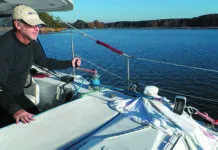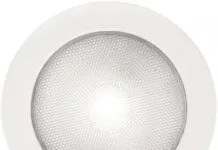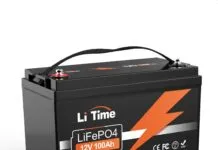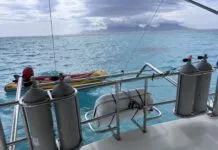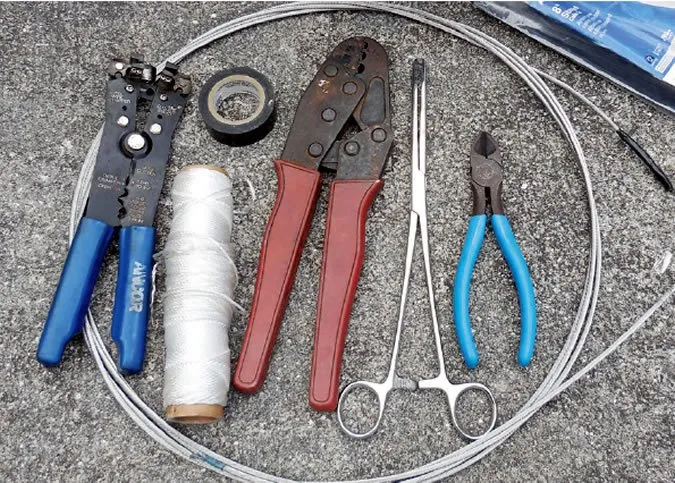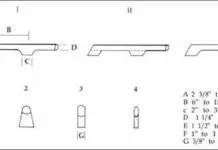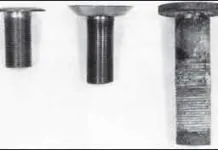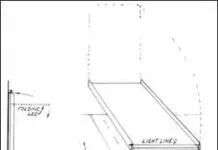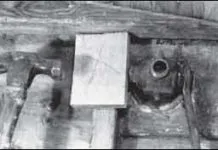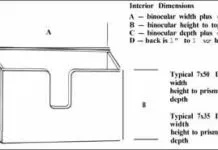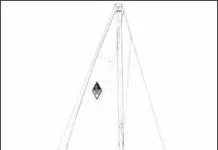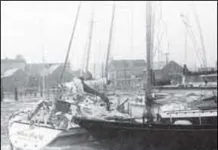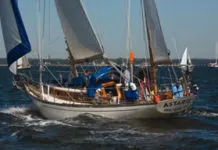A Better Way to Mount Hardware
Improperly mounted stanchion and pulpit bases are a major cause of gelcoat cracks in the deck radiating from the attached hardware. The cracks are usually the result of unequally stressed mounting fastenings or inadequate underdeck distribution of hardware loads. Frequently, a boat is received from the builder with local cracks already developed. Once the deck gets dirty enough, these minute cracks start to show up as tiny spider webs slightly darker than the surrounding deck gelcoat While repairing these cracks is a fairly difficult cosmetic fix, the underlying problem — poor mounting — is fairly easy to correct in most cases.
Sparkling Brightwork: Careful Attention to the Details
It takes practice to produce a perfect, mirror finish on varnished wood, but it is not so much a difficult task as an exacting one, where attention to detail and no short cuts are the secrets to success. Whether you are finishing new wood, refinishing old wood, or maintaining a finish in good condition, the basics are the same. Tools and materials required are sandpaper, vacuum cleaner or dusting brush, tack rag, brushes, and of course varnish and thinner If you are working from bare wood you may require stain or filler or a combination filler-stain. In cases where old wood has become discolored you will probably want to use a bleaching agent.
Design For: Building Your Own Handrails
One of the most used and easily made items of safety gear on boats is the handrail. Rare is the boat which shouldn't have handrails along the major portion of either side of the cabin top, and also down the centerline of the deck. Belowdecks, handrails are also important for safety. They are usually mounted on the cabin overhead, parallel to and on either side of the boat's centerline. To simplify mounting, the most desirable position is under the rails on deck. That way a single set of bolts can serve to fasten both rails.
Fair Through Hull Fittings: Essential to a Smooth Bottom
In light air, a major portion of the total resistance of a sailboat derives from skin friction. To oversimplify, the smoother the boat's "skin" — the submerged part of the vessel — the less power is required to drive it to a given speed. Put another way, given two boats identical in every way, including sail area, the boat with the smoother bottom will be slightly faster than a boat with a rough bottom in light air. Most racing sailors have learned the value of a smooth bottom. Ironically, cruising sailors can benefit at least as much from the creation of a low-resistance bottom as racing sailors, although you rarely see a cruising or daysailing boat with a bottom to match that of a good racing boat.
“Good Hope’s” Folding Fiddles
In a rare instance of getting to have your cake and eat it too, this design for folding fiddles affords sturdy permanent fiddles suited to the typical folding cabin table found on boats under 35', while avoiding some drawbacks of many fiddle arrangements. It has the advantage that the fiddles are always attached to the table; they do not have to be removed when the table is folded up against the bulkhead. In addition, the fiddles can be folded out of the way when the table is in use, making the table more useful for dining in harbor, when the protection of fiddles isn't usually necessary.
Keep Seacocks Working Smoothly
Are the tapered plug seacocks on your boat difficult or impossible to close? If you tighten the adjustment nut enough for them to stop weeping all over the inside of your boat, does it take two hands and a hammer to operate them? If so, it's time for an overhaul. Even if they worked well last season, a little care while the boat is hauled can save you a lot of grief in the future. As part of your boat's routine maintenance, tapered plug seacocks should be disassembled, cleaned, lubricated, and reassembled on a regular basis.
Design For: Box for Binoculars
One of the primary causes of ruin for many pairs of binoculars is that they have no home. Loose in the cockpit, or sharing a coaming locker with winch handles — their usual places — it's no wonder so many pairs die of drowning or having their prisms knocked out of alignment. It's all well and good advice to always keep binoculars in their carrying case snugly stowed in a safe place, but in practice they're in such frequent use that the advice is unrealistic. What is needed is a snug home which is both protected and accessible. A binocular box mounted just inside the companionway answers all requirements. It keeps the glasses both protected and easy to get at.
Improve Your Catalina 30: Upgrading the World’s Most Popular 30-Footer
The Catalina 30 is a remarkable success story. We suspect that more Catalina 30s have been built than any other boat of that size anywhere in the world. While the basic boat has remained unchanged since it was introduced in 1975, there have been dozens, perhaps even hundreds, of minor developments in the boat in the course of a production run that is approaching 4,000 hulls. The advantage of a boat in production for so long is a high degree of product refinement over the years. The challenge for the owner of an early version of the boat is to upgrade his boat to the standards of models currently in production.
How To Help Your Boat Survive A Major Storm
Hurricane Gloria was a most impolite lady. She barreled up the Atlantic coast, scaring the heck out of people from Florida to Massachusetts. Despite the fact that the storm didn’t live up to its billing, hundreds of boats in New York, Connecticut, Rhode Island, and Massachusetts were destroyed or severely damaged. In some cases, the boats were lost through no fault of the owner. No amount of preparation will save your boat if another boat drags down on it in the middle of a hurricane. In other cases, however, lack of proper preparation was a major cause of a damaged boat. There’s no excuse for that type of loss.
Mailport: May 2011
Letters to Practical Sailor, May 2011. This month's letters cover subjects such as: Practial Heads, Anchor Lockers, Handheld Vacs, and more!













